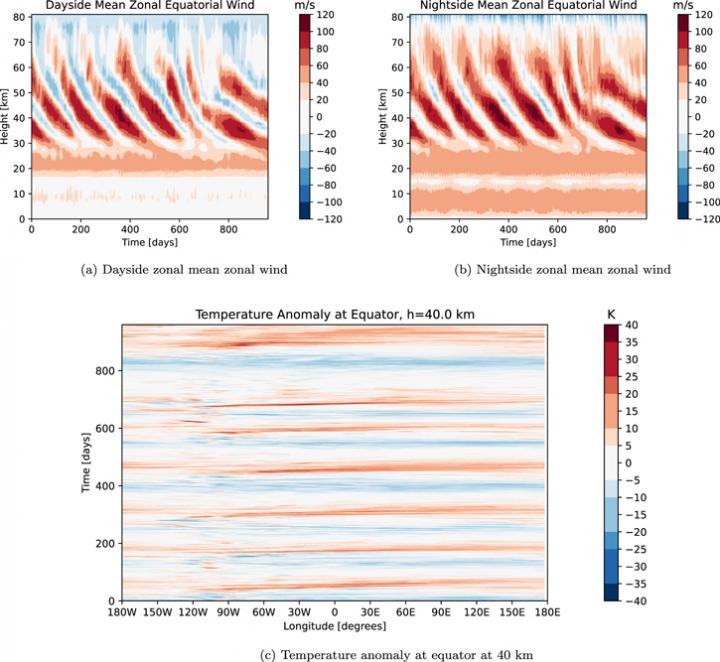Stratospheric wind and water vapour fluctuations on tidally locked exoplanets
Wind currents in the Earth’s equatorial stratosphere change direction every 26-28 months. Abundances of ozone, methane, water vapour, and other trace atmospheric gasses oscillate on the same timescale. This phenomenon is known as the “quasi-biennial oscillation” (QBO) and also occurs on other solar system planets (Jupiter and Saturn), though with different periods.
Wind currents in the Earth’s equatorial stratosphere change direction every 26-28 months. Abundances of ozone, methane, water vapour, and other trace atmospheric gasses oscillate on the same timescale. This phenomenon is known as the “quasi-biennial oscillation” (QBO) and also occurs on other solar system planets (Jupiter and Saturn), though with different periods. It occurs because atmospheric waves travelling in opposite directions are absorbed in different levels of the upper atmosphere, creating a pattern of stacked, opposing jets that propagates downwards over time.

For the first time, we simulated a QBO-like oscillation in a numerical model of the atmosphere of a tidally locked planet. Because tidally locked planets always have one hemisphere facing their host star and one facing away, they have different heating, convection, and wind patterns than rapidly rotating planets like Earth. Our study explores how these differences affect the simulated planet’s QBO.
One major difference we found is that the magnitude of the oscillation is greater and the period shorter than on Earth. Models tend to predict high wind speeds for tidally locked planets (Figure). Matching this, we found that eastward winds reached 100-120 m/s and westward winds 60-70 m/s. The water vapour abundance at a given altitude in the atmosphere also varied by up to 100%, much larger than the 3-4% found on Earth. The magnitude and period of the oscillation are related to the flux of convectively generated atmospheric waves, which may be large on a tidally locked planet because of intense convection on the dayside.
Another difference we found is a striking longitudinal asymmetry in the oscillation. On Earth, the QBO is roughly symmetric around the planet when it comes to the wind speeds and the time when the jets reverse direction. In our simulation, the oscillation was strongest on the dayside and very weak on the nightside. Winds first began to reverse direction near the planet’s western terminator (90W) and it took a few days for the reversal to spread eastward to the rest of the planet. We believe this asymmetry may be caused by the contributions of two permanent cyclone-anticyclone pairs to the background flow, which determines where the atmospheric waves driving the oscillation are absorbed. We named this analogue of the QBO a longitudinally asymmetric stratospheric oscillation (LASO).
To see whether an oscillation like this could affect observations, we simulated transmission spectra for days on which the water vapour abundance was highest and lowest. The transit depth of water vapour absorption lines at the maximum of the oscillation was about 5-10% greater than at the minimum. Planets which sustain an oscillation like this, whether Earth-like or gas giants, may have detectable amounts of atmospheric species during the high-abundance phase and not during the low-abundance phase, or may varying transmission spectra when observed at different times.
The study was led by Maureen Cohen and appeared in The Astrophysical Journal.
Link: https://iopscience.iop.org/article/10.3847/1538-4357/ac625d

